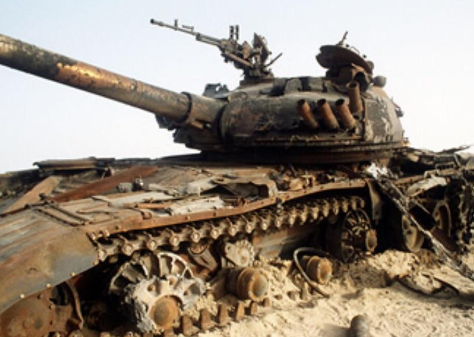This post will examine the losses of both the US-led coalition forces and Iraqi Army during the gulf war of 1991. The losses were incredibly one sided, with the US losing a handful of tanks and armored vehicles, while the Iraqi Army lost thousands.
Losses:
US/Coalition forces:
31 Tanks
28 M2 Bradley
1 M-113
1 artillery piece
Iraqi Army:
3,300 tanks
2,100 APCs
2,200 artillery pieces
This staggering disparity between the two sides was due to a few key factors. The US coalition had total air superiority and was able to strike targets all over Kuwait and Iraq. The Iraqi Army was also poorly trained and poorly motivated, along with having outdated equipment.
The Iraqi Army deployed T-55s, Type 69s, T-62s and T-72M1s against modern M1 Abrams tanks.
The M1 Abrams during the Gulf War.
The T-55 is the most ever produced tank, with some 100,000 being built. At the time of their first production they were quite an advanced design, but by 1991 that was no longer the case. Its 100mm gun was unable to penetrate the M1 Abrams even at relatively close distances, and Iraqi T-55s also did not use modern shells. The case is the same for the Type 69, which is the Chinese made copy of the T-55. Almost 2,000 T-55s were owned by Iraq before the Gulf war, and about 1,500 Type 69s.
The T-62 had slightly better armor and a slightly larger gun, but was still totally inadequate against the Abrams. Iraq had about 2,800 T-62s before the Gulf war.
The T-72M1 was the most modern tank Iraq possessed, but it had many shortcomings as well. It's 125mm gun was fairly capable assuming it was using modern ammunition. Iraq, however, did not not use modern APFSDS shells and on top of this none of their tanks had a fire control system or even thermal sights. Even if the T-72M1 spotted the Abrams first, it was unlikely to hit it, let alone penetrate the Abram's thick composite armor. Iraq had approximately 1,000 T-72 tanks at the start of the Gulf War.
On top of inadequate tanks, Saddam's army had very few anti-tank guided missiles. The Iraqi Army in 1991 had Malyutkas, Fagot and HOT ATGMs. Malyutkas are very difficult to control and master for an operator, and they are all but ineffective against modern tanks. Fagots were more capable, but there were not enough in the Iraqi Army inventory to make a difference. HOT ATGMs were mostly launched from SA 342 Gazelle helicopters, so it was difficult to get near US forces with these.
The Iraqi T-72M1, the pride of Saddam and the Republican Guard.
Iraq misinterpreted what kind of war the Gulf War would be. Saddam intended it to be another Vietnam for the US, but that is not how it played out. The Iraqi Army went in as a conventional force, making it easier to fight for the coalition. Technology had also advanced significantly since Vietnam. The catastrophic result would be thousands of Iraqi tanks destroyed. It would not be the war of attrition that Saddam intended.
Destroyed T-72M1
Destroyed T-55.
Destroyed Brazilian-made EE-9 Cascavel.
Destroyed T-62s.
Destroyed Type 69.
Destroyed T-55 Enigma, an up-armored Iraqi version of the T-55.
A destroyed US Bradley IFV. It was hit by an Iraqi T-72. One of the few victories Iraq would make against US armored vehicles.
The Gulf War was a monumental failure for the Iraqi Army. Iraq's tank force was reduced by almost two thirds. Saddam's plan for attritional warfare had only caused attrition on his own side. Tactics changed very little in 2003, and with fewer tanks to go up against the coalition, Saddam was deposed quickly. This is an example of how not to fight a war with a world power that has modern tanks and air superiority.











So how would you have fought it ? Assuming with the same weapons and armaments .
ReplyDelete